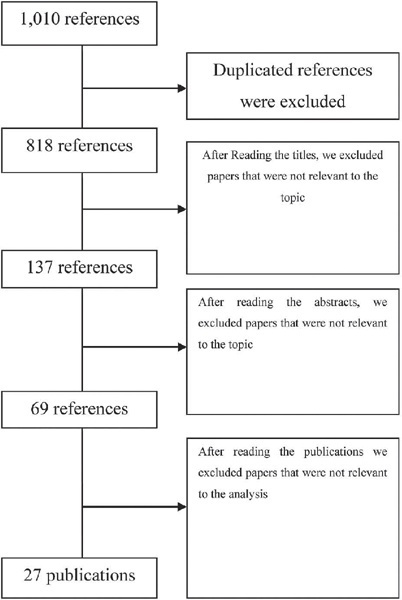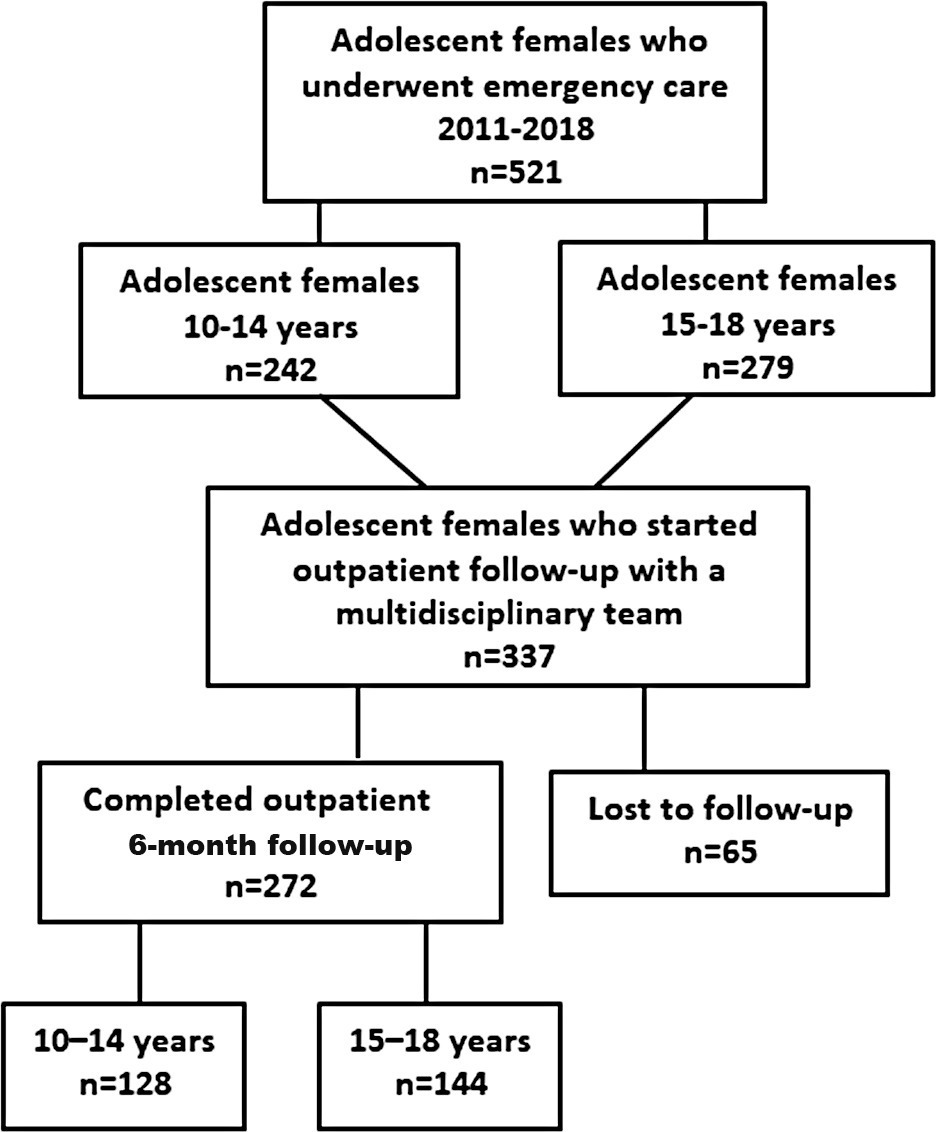Summary
Rev Bras Ginecol Obstet. 2024;46:e-rbgo17
To determine the prevalence of anxiety, depression and burnout in residents of Gynecology and Obstetrics during COVID-19 pandemic in Brazil and its associated factors.
Cross-sectional study involving all regions of Brazil, through the application of a sociodemographic questionnaire, the Hospital Anxiety and Depression Scale (HAD) and the Maslach Burnout Inventory (MBI-HSS) instrument. Multivariate analysis was performed after adjusting the Poisson model.
Among the 719 participating medical residents, screening was positive for anxiety in 75.7% and for depression in 49.8% of cases. Burnout syndrome was evidenced in 41.3% of the physicians studied. Those with depression are more likely to have anxiety (OR 0.797; 95%CI 0.687 - 0.925) and burnout syndrome (OR 0.847 95%CI 0.74 - 0.97). Residents with anxiety (OR 0.805; 95%CI 0.699 - 0.928) and burnout (OR 0.841; 95%CI 0.734 - 0.963) are more likely to have depression.
High prevalence of anxiety, depression and burnout were found in residents of Gynecology and Obstetrics in Brazil, in addition to important correlations between anxiety-depression and depression-burnout.
Summary
Rev Bras Ginecol Obstet. 2023;45(3):149-159
This article aims to review the literature regarding the use of technologies to promote mental health for pregnant women. We seek to: understand the strategies that pregnant women use for mental health care. Also, we investigate the existence of scientific evidence that validates such practices.
This study follows the PRISMA guidelines for systematic reviews. We analyze 27 studies published between 2012 and 2019. We include publications in Portuguese, English, and Spanish.
The results revealed several different possibilities to use technology, including the use of text messages and mobile applications on smartphones. Mobile applications are the most commonly used approaches (22.5%). Regarding the strategies used, cognitive-behavioral approaches, including mood checks, relaxation exercises, and psychoeducation comprised 44.12% of the content.
There is a need for further investigation and research and development efforts in this field to better understand the possibilities of intervention in mental health in the digital age.

Summary
Rev Bras Ginecol Obstet. 2022;44(7):667-677
To compare the sexual violence suffered by women in early and late adolescence, the reactions triggered after the aggression, and the care provided.
A retrospective study in which we reviewed the medical records of 521 female adolescents treated by a multidisciplinary team at a reference hospital in the city of Campinas, state of São Paulo, Brazil. We analyzed sociodemographic variables, and those pertainin to the characteristics of the episodes of violence, the emergency care, and the physical and psychological reactions observed during the follow-up. For the analysis, the sample was divided into groups of early (10 to 14 years) and late (15 to 18 years) adolescence. We used the Chi-squared/Fisher Exact, Mann-Whitney, and Kruskal-Wallis tests to compare the groups; the level of significance adopted was 5%.
The early group (n= 242) contained more adolescents who were enrolled in school (p< 0.001), suffered more daytime aggressions (p= 0.031), in their residences (p< 0.001), by an aggressor with whom they were acquainted (p< 0.001), had greater need of legal protection (p= 0.001), and took longer to seek care (p= 0.048). Feelings of guilt, shame, and the perception of violence were similar between the groups. In the late group (n= 279), there was greater consumption of alcohol during the aggression (p= 0,005); they received significantly more prophylaxis treatments; reported more physical symptoms (p= 0.033), sleep disorders (p= 0.003), symptoms of anxiety (p= 0.045), and feelings of anguish (p= 0.011); and had more prescriptions of psychotropics (p= 0.005). Only 52% completed the 6-month follow-up, with no differences between the groups.
The age groups showed differences in the characteristics of the episodes of violence; early adolescents took longer to seek help, and the late group presented more intense symptoms and psychological worsening during the follow-up. Measures of prevention and specific care aimed at this population are needed.

Summary
Rev Bras Ginecol Obstet. 2022;44(4):343-351
To evaluate the emotional and clinical aspects observed in women with gestational trophoblastic disease (GTD) followed-up in a reference center (RC) by a multidisciplinary team.
Retrospective cohort study of the clinical records of 186 women with GTD and of the emotional aspects (EA) observed in these women by a teamof psychologists and reported by the 389 support groups conducted from 2014 to 2018.
The women were young (mean age: 31.2 years), 47% had no living child, 60% had planned the pregnancy, and 50% participated in two or more SG. Most women (n=137; 73.6%) reached spontaneous remission ofmolar gestation in a median time of 10 weeks and had a total follow-up time of seven months. In the group of 49 women (26.3%) who progressed to gestational trophoblastic neoplasia (GTN), time to remission after chemotherapy was 18 weeks, and total follow-up time was 36 months. EA included different levels of anxiety and depression,more evident in 9.1% of the women; these symptoms tended to occur more frequently in women older than 40 years (p=0.067), less educated (p=0.054), and whose disease progressed to GTN (p=0.018), as well as in those who had to undergo multi-agent chemotherapy (p=0.028) or hysterectomy (p=0.001) adjuvant to clinical treatment.
This study found several EA in association with all types of GTD. It also highlights the importance of specialized care only found in a RC, essential to support the recovery of the mental health of these women.
Summary
Rev Bras Ginecol Obstet. 2016;38(12):609-614
To assess depression, domestic violence and the use of substances in women with recurrent miscarriages.
The Abuse Assessment Screen (AAS), the Edinburgh Postnatal Depression Scale (EPDS) and the Alcohol, Smoking and Substance Involvement Screening Test (ASSIST) were used to assess violence, depression and the use of substances among women with recurrent miscarriages. The population corresponded to patients receiv-ing prenatal care from June to August 2014. Multiple logistic regression was used to assess the multivariable relationship between depression and sociodemographic, psychosocial and medical characteristics (p < 0,10).
The prevalence of depression was of 41.3% (95% confidence interval [CI] 1/4 28.3-55.7%). One third of the pregnant women (32.6%) reported emotional or physical violence, and 13% were classified as abusing or addicted to tobacco according to ASSIST. History of psychiatric diseases was associated with depression (p 1/4 0.005). Violence during life demonstrated a modest association (p 1/4 0.073) with depression, as well as the number of miscarriages (p 1/4 0.071).
Depression is a frequent disease among pregnant women with recurrent miscarriages. The results of this investigation suggest that a systematic assessment of depression and its associated conditions, such as domestic violence and the use of substances, should be part of the prenatal follow-up visits for women with recurrent miscarriages.
Summary
Rev Bras Ginecol Obstet. 2012;34(10):442-446
DOI 10.1590/S0100-72032012001000002
PURPOSE: To evaluate the prevalence of common mental disorders in women diagnosed with polycystic ovary syndrome as compared with paired controls without this syndrome. METHODS: Cross-sectional study with a Control Group examining women between the ages of 18 and 30 who did not use antidepressants and who sought the Gynecology Service of the researched sites. For every woman diagnosed with the polycystic ovary syndrome, another with the same age, educational status and presence or absence of sexual partners was sought without this diagnosis. In total, 166 patients agreed to participate, consisting of 95 diagnosed with polycystic ovary syndrome and 71 in the Control Group. The diagnosis of polycystic ovary syndrome was made by the presence of two from three criteria: oligomenorrhea or amenorrhea, clinical or biochemical hyperandrogenism and polycystic ovaries on transvaginal ultrasound, following exclusion of patients with Cushing's syndrome, congenital adrenal hyperplasia, and androgen-secreting tumors. Weight and height were measured to calculate the body mass index. The Self-Reporting Questionnaire, which evaluated 20 items, was used as an indicator of common mental disorders. A χ² analysis stratified by the category of body mass index was used to compare the prevalence of common mental disorders, between the groups of women with and without the polycystic ovary syndrome. RESULTS: There were no significant differences in age, education, presence of sexual partners, ethnicity, socioeconomic status, use of psychiatric medication, and search for consultation in mental health between the studied groups. The prevalence of obese women with indications of common mental disorders was significantly higher in women with polycystic ovary syndrome than in the Control Group. In the group with healthy body mass index, the incidence of common mental disorders was statistically significant different between women with polycystic ovary syndrome and normal controls (p=0.008). CONCLUSIONS: Women with diagnosis of this disease have an almost three-fold increased likelihood of common mental disorders as compared with those without polycystic ovary syndrome. Although obesity is often observed in polycystic ovary syndrome, even women with a healthy body mass index have an increased risk of psychiatric comorbidity.
Summary
Rev Bras Ginecol Obstet. 2011;33(9):252-257
DOI 10.1590/S0100-72032011000900006
PURPOSE: To describe and compare the phases of stress of primiparae in the third trimester of pregnancy and postpartum, associating them with the occurrence of postpartum depression. METHODS: The study consisted of two stages (Stage 1 and Stage 2), characterized as longitudinal research. Ninety-eight primiparae participated in Stage 1, and 64 of them participated in Stage 2. In Stage 1, data were collected in the third trimester of pregnancy, and in Stage 2, at least 45 days after delivery. The Stress Symptoms Inventory Lipp (ISSL) was applied in Stage 1 and an interview was held to characterize the sample. In Stage 2, we applied again the ISSL and also the EPDS (Edinburgh Postnatal Depression Scale). Data were analyzed using SPSS for Windows®, version 17.0. The statistical analyses were performed using the Student’s t-test and the Spearman p. RESULTS: Seventy-eight percent of the participants showed significant signs of stress in the third quarter and 63% of them during the postpartum period, with a significant difference in the stress occurring in the third trimester and postpartum (t=2.20, p=0.03). There was also a correlation between the stress occurring during pregnancy and in the puerperium and the manifestation of postpartum depression (p<0.001). CONCLUSION: More than half of the women experience significant stress signs during both pregnancy and the postpartum period. However, the frequency of onset of significant symptoms of stress was higher during pregnancy than during the puerperium. These results seem to be closely related to the manifestation of postpartum depression, indicating the relationship between stress and postpartum depression.
Search
Search in:
breast (42) breast cancer (42) breast neoplasms (95) Cesarean section (72) endometriosis (66) infertility (56) Maternal mortality (43) menopause (82) obesity (58) postpartum period (40) pregnancy (225) Pregnancy complications (99) Prenatal care (68) prenatal diagnosis (50) Prevalence (41) Quality of life (51) risk factors (94) ultrasonography (79) urinary incontinence (40) women's health (48)